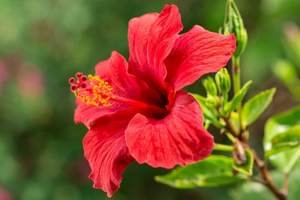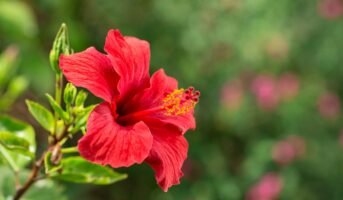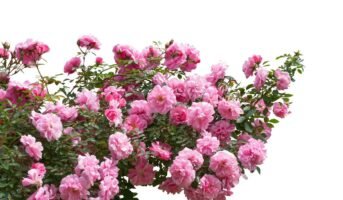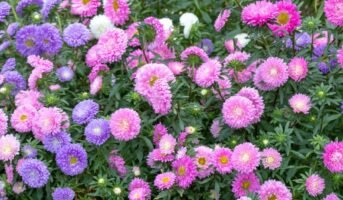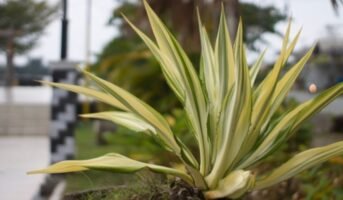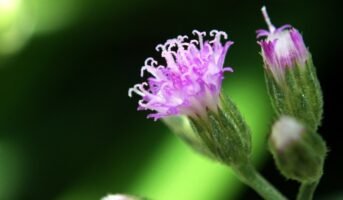The one plant that may be found in the majority of gardens is the Hibiscus plant with its vibrant, tropical flowers. The Latin scientific name for tropical Hibiscus is rosa-sinensis, which actually refers to the “rose of China.” Our tropical Hibiscus is also known as the Chinese hibiscus, China rose, Hawaiian hibiscus rose mallow, shoe flower, and shoeblack plant.
The trumpet-shaped flowers of the shoe plant tree can appear on either annual or perennial herbaceous plants. This tropical plant prefers slightly acidic, well-drained soil with full or partial sun.
See also: Tips to grow and take care of anthurium
Shoe flower: Key facts
| Common name | Shoe flower plant, hibiscus |
| Botanical name | Hibiscus spp. |
| Mature size | 3-10 ft. tall and 2-8 ft. wide |
| Sun | Full sun, partial sun |
| Soil | Moist, well-drained |
| Soil pH | Acidic, neutral |
| Bloom time | Summer, fall, and year-round in tropical climes |
| Flower colour | Red, pink, white, yellow, orange, purple |
What is Hibiscus?
Hibiscus is a class of flowering plants in the mallow family. These are known to be quite large in size, and comprise of hundreds of species. The plants are native to warm temperate, subtropical, and tropical areas of the world. Generally, these are annual or perennial herbaceous plants.
Shoe flower: Physical characteristics
Perennial shoe plant can grow as high as 2 metres in height. Between two and three inches in length, hibiscus leaves might be triangular, ovate, or diamond in shape. In late summer and early fall, the shoe plant blooms with a rainbow of colours, including red, pink, and white. The diameter of these enormous blossoms can reach 6 inches, which is the size of a standard paper plate.
A fully developed shoe plant blossom can measure up to 10 inches in diameter. The huge, trumpet-shaped blossoms can have anywhere from five to ten petals, and they can be seen in a rainbow of patterns and hues of white, pink, orange, red, yellow and purple.
The large openings of hibiscus flowers entice all sorts of pollinators, from bees to hummingbirds, to take a sip of nectar.
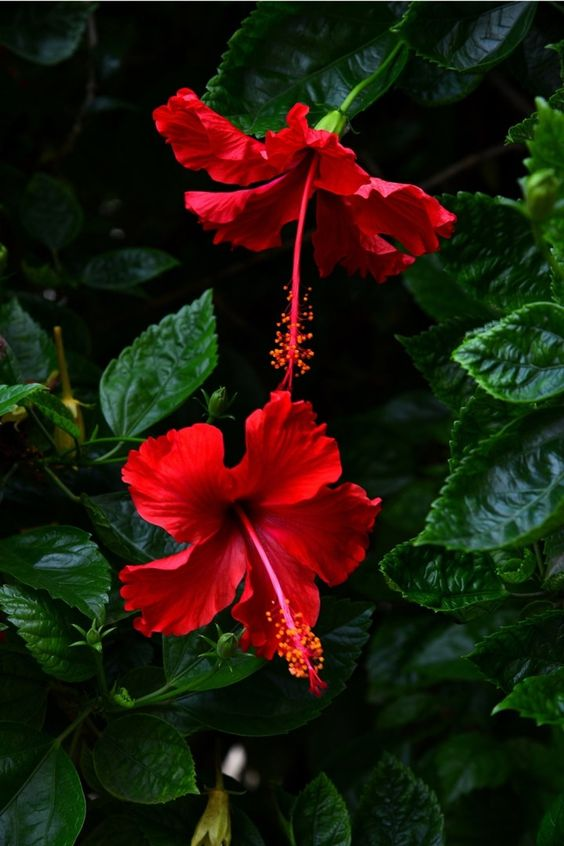
Source: Pinterest
Different colours of hibiscus flowers
- Bluebird: This variety is a large flower with different blue shades. Typically, the edges of the petals are deeper blue shade while those towards the middle have an ombre effect, lightning towards the centre.
- Blue Chiffon: The blue chiffon flower has a soft blue colour, and the periwinkle flowers have several layers of flowers that together give a textured look.
- Cotton Rose: This is a rose-like flower variety of the hibiscus. The edges of the petal have a light pink colour.
- Luna Red: This is among the most vibrant hibiscus flowers, with a bright but deep red shade.
Shape of hibiscus flowers
There are different flowers with different shapes such as bell, bowl, funnel, or trumpet. Hibiscus flowers have a trumpet-like shape with bright, ruffled petals. There are five or more large petals in one flower. They are typically 4 to 18 cm broad in size.
Shoe flower: How to grow?
From cuttings
Shoe plants are usually spread by means of cuttings. Take a snip of the stem that’s four to six inches long from a healthy, recent shoot. The leaves closest to the stem should be kept, but the remainder should be cut off. Before placing the cut end into well-drained, wet potting soil, you may want to apply a rooting hormone. The root system may take a few months to mature.
From seed
Shoe plants are challenging to grow from seed, making cuttings a more reliable method of propagation. They usually need a lot of care and time to germinate.
If you soak your seeds for up to eight hours, you can speed up the germination process by nicking the hard seed coating slightly and allowing more moisture to permeate the seed. Plant seeds a quarter of an inch deep in a warm, sunny spot (at least 75 degrees Fahrenheit) for optimal growth.
Expect seedlings to emerge in a couple of weeks. Their tender stalks necessitate a patient translation and a slow but steady hardening.
Shoe flower: Plant care
Light
Conditions of high brightness are ideal for shoe plants. While full sun is preferable in the cooler northern climates, the drier, hotter southern regions require filtered sunshine. If your plant isn’t flowering, try relocating it to a brighter spot.
Shoe plants grown inside need indirect, bright light from a window but should not be exposed to direct sunlight. When the weather gets warmer, you can move your plants outside, but you should gradually introduce them to the brighter circumstances outside.
Soil
Shoe plants thrive on soil that is rich, loamy, and moist. The hardy species are native to wet areas and are a suitable option for locations where other plants might die from too much moisture.
Although most shoe plants require a somewhat acidic soil pH, the rose of Sharon may thrive in a more alkaline environment. The soil acidity level can change the hue of shoe plant blossoms.
If you’re having dry circumstances, mulching around the plant’s base can help. Adding organic matter to soil that lacks nutrients will improve its quality.
Water
All shoe plants, regardless of species, require consistent moisture to thrive. From spring until early fall, when the tropical shoe plant you keep indoors is actively growing, they need regular watering. Drought conditions call for drastic water reductions.
Make sure containers have enough drainage holes, and allow the top inch or two of potting mix to dry out before watering plants that are grown in containers. Soaked soil is just as bad.
You may encourage your shoe plant to blossom profusely by watering it every day, but this will depend on the weather and other factors.
Water your hardy shoe plant often to keep them moist if you haven’t placed them near a pond or other wet location.
Temperature and relative humidity
A cold, moderate climate is ideal for growing the shoe plant. Temperatures between 60 to 90 degrees Fahrenheit are ideal for them, although they can survive down to 20 degrees Fahrenheit if necessary.
Plants in containers need to be brought inside when the temperature drops below 30 degrees Fahrenheit to prevent frost damage. Bathrooms are an ideal environment for these plants because of the high humidity levels found there.
Tropical kinds are sensitive to temperatures below 50 degrees Fahrenheit and should be kept in a humid environment indoors if you live in an area where this is likely to happen.
Fertiliser
Fertilise your plants with a mixture of high potassium and high nitrogen to promote lush growth and vibrant flowers. Some examples of organic fertilisers include fish emulsion and seaweed extract. Start feeding a dilute solution a few weeks before blooming begins and do so at least once a week until blooming is complete.
Pests
While shoe plants are generally free of pests and diseases, low humidity can invite red spider mites. Aphids can also be a problem, but they can be managed with consistent washing and insecticidal soap.
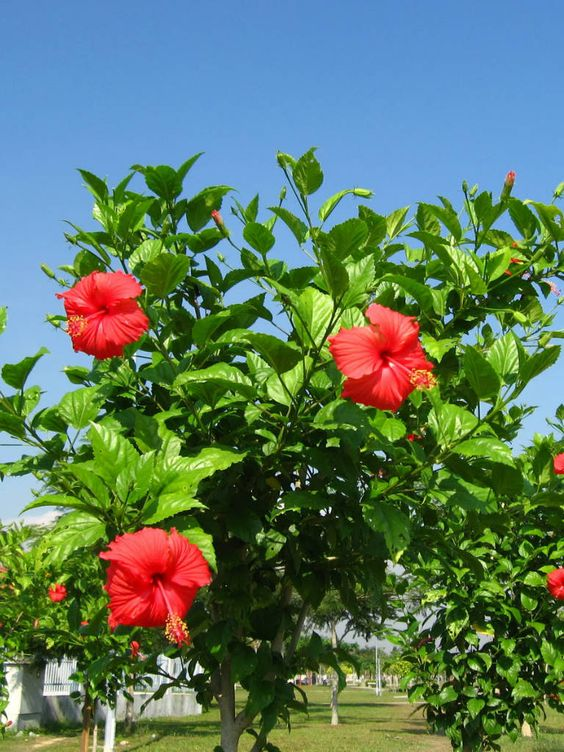
Source: Pinterest
Shoe flower: Uses
- Soaps and scrubs can be made with edible shoe plant seed oil in place of castor oil.
- Seeds and flowers are utilised as coffee substitutes and organic herbal tea.
- It is common practice to utilise shoe plant leaves in many dishes. The uncooked leaves provide nutritional value.
- Red calyces are used as food colours and colourants.
Medicinal benefit
- It’s anti-inflammatory.
- Has the potential to reduce blood pressure.
- High levels of beneficial antioxidants can be found in shoe plant tea.
- Possible aid in reducing fat levels in the blood.
- Could improve liver function.
- May help with weight reduction.
- Benefit in hair growth.
Benefits of hibiscus tea
Hibiscus tea is a widely popular herbal tea. It is known to be rich in antioxidants and has many health benefits. It has properties that are believed to lower blood pressure, lower body fat, and enhance liver health. Hibiscus tea also helps in fighting bacterial infections.
Shoe flower: Toxicity
The shoe plant is completely non-toxic to people, making it an excellent choice for nurseries and playrooms full of young children and infants.
FAQs
What about shoe plant leaves? Are they edible?
The flowers, leaves, and seeds of this plant can all be eaten.
Is shoe plants iron-rich?
Shoe plant flowers, which are rich in iron, are often used to increase mental and physical stamina.
Do you know that shoe plant prevents hair loss?
Shoe plants can nourish hair naturally, and prevent hair loss and premature greying.
Housing News Desk is the news desk of leading online real estate portal, Housing.com. Housing News Desk focuses on a variety of topics such as real estate laws, taxes, current news, property trends, home loans, rentals, décor, green homes, home improvement, etc. The main objective of the news desk, is to cover the real estate sector from the perspective of providing information that is useful to the end-user.
Facebook: https://www.facebook.com/housing.com/
Twitter: https://twitter.com/Housing
Email: [email protected]
